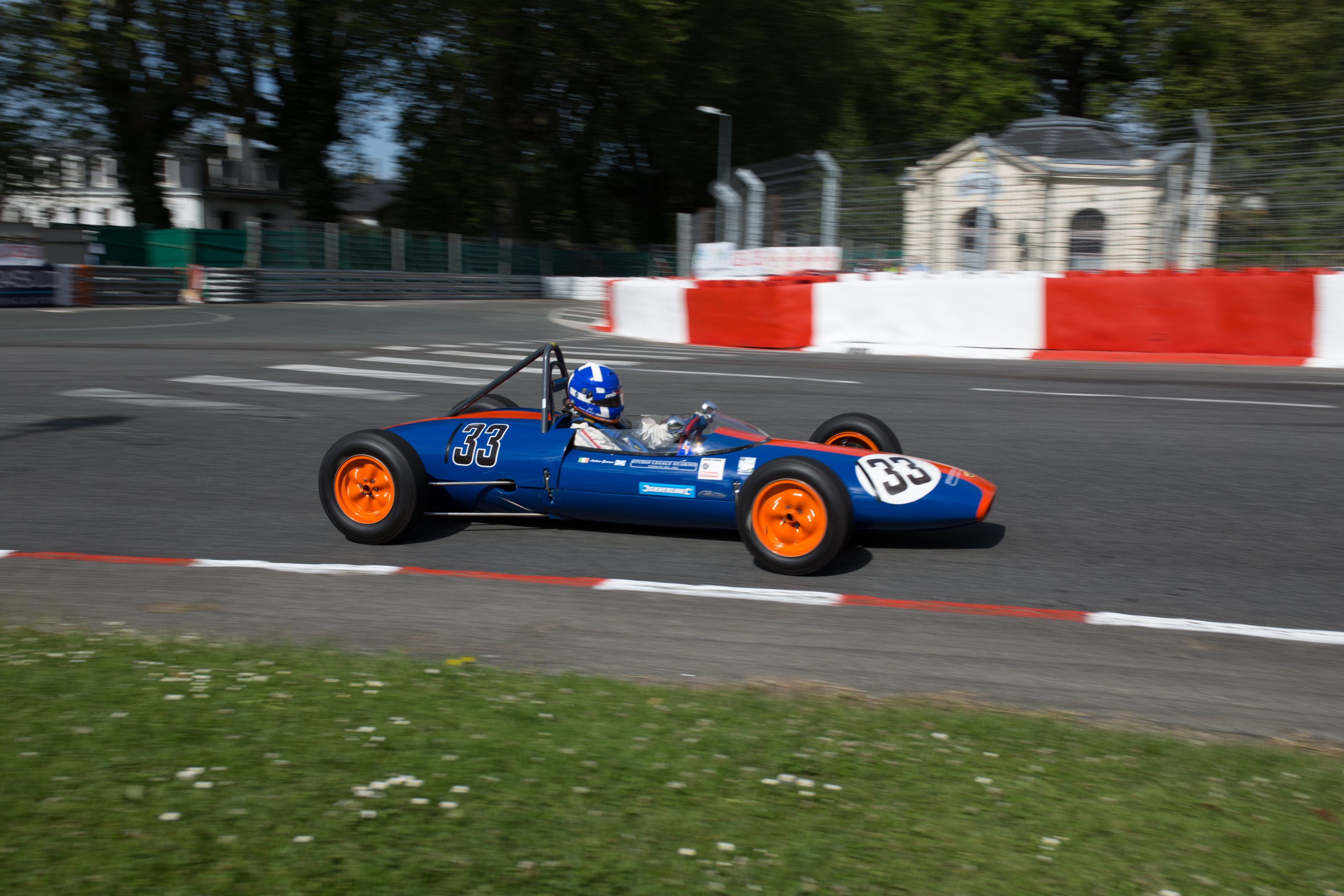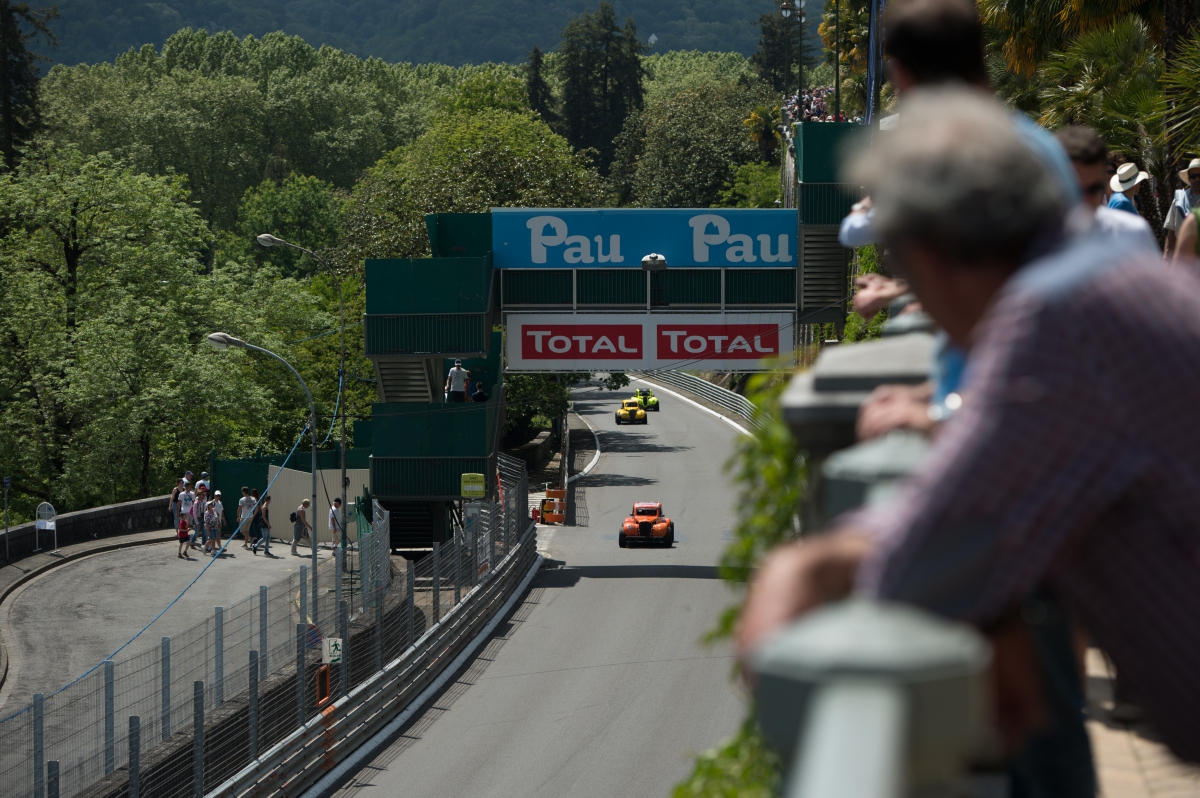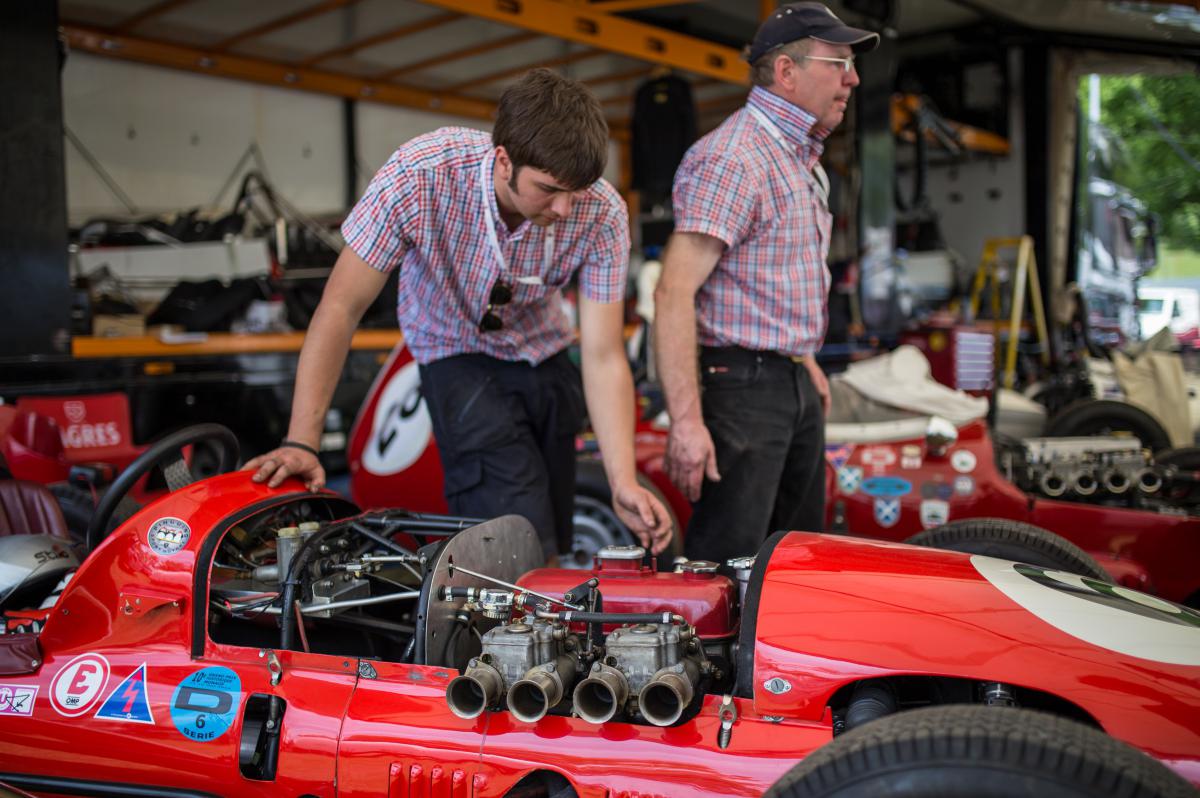Grand prix historique de Pau, en piste !
Des voitures mythiques. Des rugissements de fauves mécaniques. Des pilotes d’exception venus du monde entier. Un étroit ruban de bitume cerné de trottoirs. Des rails plus menaçants que rassurants. Des appareils photo. Des curieux. Des passionnés. Surtout des passionnés. Tels sont les ingrédients du Grand Prix Historique de Pau qui se déroule comme chaque année en mai, en plein centre de la cité d’Henri IV. Voyage au coeur d’un circuit légendaire de Formule 3.
« Seule la course vaut d’être vécue. Pendant le reste de son existence, on ne fait qu’attendre. »
Cette phrase de Steve McQueen pourrait être celle de tous les pilotes rencontrés dans les paddocks du Grand Prix Historique de Pau. Mêmes obsessions, mêmes défis insensés, comme le comédien dont le coeur ne battait jamais si fort que dans la fièvre d’une course. Ici pas de flambe. On vient pour offrir du spectacle. À l’invitation du promoteur HVM Racing, ce sont près de 250 voitures de course anciennes qui prennent possession du circuit urbain de la cité paloise. Fidèle à son statut international, il réunit des pilotes venus d’une vingtaine de pays différents. Et c’est un enchantement. Un véritable retour dans le passé. « Maurice Trintignant, Wimille, Sommer, Behra, Clark, G. Hill, J. Stewart, Fangio, Beltoise, Pescarolo, Alain Prost, Montoya, Barrichello, Damon Hill… toutes les grandes figures du sport automobile se sont affrontées sur cette boucle. » Quand il parle du Grand Prix, Laurent Valléry-Masson, pilote mais surtout organisateur de ce concept sportif, a des étoiles plein les yeux. « Petit, je venais ici avec mon père. Il était commissaire, il agitait les drapeaux ! Sans doute pour cette raison que j’ai toujours voulu être pilote… » Aujourd’hui, il gère le contenu sportif de l’événement : « Il faut trouver un équilibre pour bâtir l’affiche de ce meeting international. La concurrence est très forte notamment avec Monaco et Le Castellet. Il n’y a pas vraiment de cahier des charges. Il faut surtout rassembler un maximum de pilotes et de belles autos, de manière à garantir un spectacle vraiment populaire. »
« Les stars sont les voitures,
pas les pilotes ! »
La particularité du Grand Prix Historique de Pau, c’est le choix des bolides. « Ils sont beaux et ne sont là que pour la course. Je construis des catégories à condition que la voiture m’intéresse, précise Laurent Valléry-Masson. C’est ainsi que je choisis des minis, des Jaguar, des protos (il n’y en a pas à Monaco), des monoplaces, des GT… Il faut pouvoir offrir un cadre qui rassemble tout le monde. » Ici pas d’espionnage industriel comme en Formule 1, pas d’individus d’écuries concurrentes habillés en touristes avec un appareil à la main en train de mitrailler un moteur, essayant de se faire discrets à l’entrée du stand, pas de bidons d’essence dérobés, pas de véritable armée de vigiles testostéronés, pas de paparazzi à l’affût de têtes couronnées, de personnalités connues ou de stars de ciné. On entre au Grand Prix Historique comme on va au cinéma. Et ce n’est pas le long dédale de marches assez raides pour accéder aux paddocks qui vont empêcher les familles, même avec poussettes, d’aller voir au plus près ces voitures de légende. Le circuit n’est pas non plus truffé de recoins, d’entrées de tunnels sombres, de motor-home enchevêtrés, de coursives improvisées, de grillages trop faciles à escalader. On l’aura compris, Pau n’est pas Monaco. Et c’est tant mieux. Voir les mécaniciens brancher des PC sur les monoplaces, ça ne fait pas rêver. Alors qu’ici ce sont souvent les pilotes eux-mêmes qui mettent les mains dans le cambouis.
« Sur une voiture moderne, on tourne la clef, ça démarre ! Sur les voitures des années 60, 70, ce n’est pas aussi simple ! rappelle notre sportif éclairé. Le GPH est complètement autonome. C’est une histoire de passion. Un pilote ne supporte pas qu’un mécano touche à sa voiture ! »
« Les circuits en ville,
c'est vraiment une race à part ! »
Tony Olissoff vient de Nouvelle-Zélande. C’est la troisième fois qu’il court à Pau. La première fois, il était venu seul avec sa monoplace titiller le circuit en formule junior. La seconde fois, il a ramené ses copains, chacun son bolide, aux couleurs de leur Kiwiteam. Il n’a pas de mécano mais aime rouler des mécaniques. « Il y a trois personnes pour s’occuper de ma voiture : me, myself and I, dit-il en riant, et j’ai tout intérêt à ce qu’elle marche bien. Piloter en ville, c’est impossible à décrire. Vous avez le contrôle d’un monstre, vous maintenez une vitesse sur des zones où vous ne devriez jamais la maintenir. Le circuit est très dangereux. Alors je reste toujours au milieu ! » Même constat pour Laurent Valléry-Masson qui avoue qu’il faut avoir une sacrée dose d’inconscience pour piloter en circuit urbain. « C’est très rapide et visuellement assez terrifiant. Il y a beaucoup de virages en aveugle, ça passe ou ça casse. On ne peut pas anticiper. C’est un Monaco puissance 10. Les circuits en ville, c’est vraiment une race à part ! » Iria et Maria Fernandez, deux soeurs venues d’Espagne qui ont fait leur premier Grand Prix Historique l’année dernière dans la catégorie « Historic Endurance pré 76 GT », sont aussi du même avis : « Ce circuit est très technique. Si tu fais une erreur, tu te crashes. » Masami Fujita, quant à lui, à la tête d’une très grosse entreprise japonaise, ne raterait pour rien au monde ce rendez-vous annuel.
Au volant de son Alfa Giulia Sprint, c’est la cinquième fois qu’il participe : « Ici, je ne suis pas connu mais je suis un bon pilote. J’aime le contact avec les gens, la promiscuité. On m’a même demandé un autographe ! J’adore Pau ! ». Et puis il y a les « chouchous » du Béarn tel que François Tillos, le patron du restaurant Le Berry, une institution paloise, qui dispute avec son frère Jackie depuis plusieurs années déjà le Trophée Maxi 1000 à bord de leur Morris Cooper S. La descente qui emmène vers Poeymirau a même été baptisée « François Tillos » suite à ses exploits passés en Legends Cars !
« Ce circuit est très technique. Si tu fais une erreur, tu te crashes. »
« Pau, c'est la petite Monaco »
« Monter un circuit en plein centre-ville, c’est une sacrée organisation. » Et Joël Do Vale, président de l’Asac, organisateur administratif et technique du Grand Prix sait de quoi il parle : « Chaque année, nous sommes confrontés aux mêmes problématiques : gérer les riverains, l’électricité, Internet… Nous avons en moyenne entre 500 et 600 bénévoles (dont 200 commissaires), une trentaine de secouristes, 5/6 médecins, une vingtaine de pompiers… en tout près de 1000 personnes assurent le bon fonctionnement de ce rendez-vous traditionnel de la course dans le Béarn. Il faut donc, plus qu’ailleurs, le soutien de bénévoles et la bienveillance des Palois. » Que de chemin parcouru depuis 1933 où le secrétaire général de l’Automobile-Club Basco-Béarnais, Georges Charaudeau imagina un premier tracé au coeur du centre-ville en s’inspirant des autres compétitions de l’époque telle le Grand Prix de Monaco, apparu dix ans plus tôt, d’où son surnom de « petite Monaco ». Son tracé est alors de 2649 km. Puis ensuite porté à 2760 km. Il n’a jamais bougé depuis. La seule différence c’est qu’à cette époque il y avait 16 voitures dont 13 Bugatti. Quatre-vingt-quatre ans plus tard, le parcours du GPH de Pau réunit sept plateaux historiques particulièrement disputés avec près de 180 voitures de toutes époques sur les grilles de départ et plus de 400 magnifiques voitures de collections présentées par les Clubs sur les allées du Parc Beaumont. Et en suspens, le fantôme de Steve McQueen, jamais très loin.
Pau Historic Grand Prix, let’s hit the road!
Legendary cars. The roar of wild mechanical beasts. Elite drivers from all over the world. A thin stretch of tarmac lined by pavements. Guard rails that look more threatening than reassuring. Cameras. Curious onlookers. Enthusiasts. Lots of enthusiasts. Those are the ingredients of the Pau Historic Grand Prix that takes place every year in May, right in the heart of the city that was home to Henri IV. Let’s take a drive around the legendary Formula 3 circuit.
“Racing is life. Anything before or after is just waiting.”
The famous quote from Steve McQueen could have been said by any of the drivers you meet in the paddock at the Pau Historic Grand Prix. They have the same obsessions, set themselves the same crazy challenges, like the actor whose heart never beat as fast as it did in the heat of a race. But the drivers here come for the show, not just to be seen. Invited by the promoter, HVM Racing, around 250 vintage cars take over the urban race track in Pau city centre. True to its international status, it attracts drivers from over twenty different countries. And it’s an absolute delight, a real flashback to the past. “Maurice Trintignant, Wimille, Sommer, Behra, Clark, G. Hill, J. Stewart, Fangio, Beltoise, Pescarolo, Alain Prost, Montoya, Barrichello, Damon Hill… all the motorsport greats have fought it out on this circuit.” Laurent Valléry-Masson is a driver, but he’s also the man who organizes this sporting event, and when he talks about the Grand Prix, his eyes sparkle. “When I was little, I used to come here with my Dad. He was a race official, one of the guys who waved the flags. That’s probably why I’ve always wanted to race…”. Today, he manages the sporting aspect of the event: “I have to strike a balance when putting together the line-up for this international meeting. There’s strong competition from Monaco and Le Castellet. There isn’t really a scope of work as such. What’s really important is to make sure that there are as many drivers and fabulous cars as possible, to guarantee a show that’ll attract the crowds.”
“The real stars are the cars, not the drivers!”
The main characteristic of the Pau Historic Grand Prix is the choice of racing car. “They’re magnificent, and come here just for the race. I create categories as long as the car interests me,” explains Laurent Valléry- Masson. “That’s how I choose Minis, Jaguars, Protos (there aren’t any in Monaco), single seaters, GT models, etc. We have to propose a format that that will appeal to everybody.” And there’s none of the industrial espionage of Formula 1 racing, no members of other teams disguised as tourists, camera in hand, snapping away at an engine, or trying to keep a low profile as the car comes into the pits, no stealing drums of petrol, no army of beefed-up security guards, no paparazzi after front-page material and photos of celebrities. There’s no heightened security plan either, no bag searches. You walk into the Grand Prix like you walk into the cinema. And the winding labyrinth of pretty steep steps that lead to the paddock doesn’t stop families, even those with pushchairs, from going to see the legendary cars a little closer up. The circuit isn’t full of dark corners either, or black mouths of tunnels, huddles of motor-homes, improvised walkways, or fencing that’s all too easy to clamber over. So Pau isn’t Monaco, and it’s much better that way. Seeing mechanics connecting PCs to singleseaters is a bit of a let-down, whereas here, it’s often the drivers themselves who muck in and get their hands dirty.
“On a modern car, you just turn the key in the ignition and it starts! But when it comes to cars from the 60s or 70s, it’s a whole new ball game!” says our experienced sportsman. The HGP is a totally standalone event. It’s all about passion. A driver wouldn’t stand a mechanic meddling with his car!
“City circuits make a totally different race!”
Tony Olissoff is from New Zealand and it’s the third time he’s come to race in Pau. On his first visit, he came on his own with a single-seater to try out the circuit in the Formula Junior. On the second trip, he brought his friends with him, each with their own car, emblazoned with the colours of their Kiwiteam. He doesn’t have a mechanic but he likes roll up his sleeves and get the job done himself. “There are three people looking after my car: me, myself and I” he laughs, “and I have to make damn sure that it runs well. Driving in the city is impossible to describe. You’re at the wheel of a wild beast and you have to drive at speed in areas where you should never be able to drive that fast. The circuit is very dangerous, so I always stay in the middle!” Laurent Valléry-Masson agrees, and admits that you have to have to be pretty reckless to drive a city circuit. “It’s very fast and visually, pretty daunting. There are lots of blind bends and it’s either make or break around those. You can’t read the road ahead. It’s like Monaco, big time. City circuits are a totally different ball game!” Iria and Maria Fernandez, two sisters from Spain who raced their first Historic Grand Prix last year in the “Historic Endurance pre-76 GT” category, also share the same opinion: “It’s a highly technical circuit. Make one mistake and you crash.”Masami Fujita, head of a major Japanese corporation, wouldn’t miss this annual meeting for anything in the world. At the wheel of his Alfa Giulia Sprint, it’s the fifth time he’s been on the starting grid: “I’m not well-known here, but I’m a good driver. I love meeting people, the crowds. I was even asked for an autograph! I love Pau!” And then there are the local favourites like François Tillos, owner of the restaurant Le Berry, a real institution in Pau, and his brother Jackie who have been competing for several years in the Trophée Maxi 1000 in their Morris Cooper S. The downhill section that leads towards Poeymirau has even been christened “François Tillos” owing to his past exploits in Legend Cars!
“Pau is a mini Monaco”
“Creating a circuit right in the city centre is a mammoth organization.” And Joël Do Vale, President of the ASAC, and administrative and technical organizer of the Grand Prix, knows exactly what he’s talking about: “We have to tackle the same problems every year: managing the local residents, electricity issues, internet connections, etc. We have about 500 to 600 volunteers on average (including 200 race officials), about 30 emergency first aiders, 5-6 doctors, about 20 firefighters…around 1,000 people altogether who are there to make sure that this traditional motorsport event in Béarn runs smoothly. So more than anywhere else, we need support from the volunteers and the hospitality of the people of Pau.”
The Grand Prix has come such a long way since 1933 when Georges Charaudeau, the General Secretary of the Basque-Béarnais Automobile Club, thought up the initial circuit in the city centre, inspired by other competitions at that time, like the Monaco Grand Prix that began ten years earlier, hence its nickname ‘mini Monaco’. Back then the circuit measured 2.649 km. Later it was extended to 2.760 km, and hasn’t changed since. The only difference is that at that time, there were 16 cars, including 13 Bugattis. Eightyfour years later, the Pau GPH circuit comprises seven historic categories where competition is particularly fierce. Some 180 cars from all epochs rev their engines on the starting grids and over 400 magnificent vintage cars are presented by the Clubs on the alleyways of the Parc Beaumont. And somewhere out there, the ghost of Steve McQueen is never far away.
BLOSSOM #04
Visite privée
Grand Prix Historique de Pau, en piste !
Rédaction : Catherine NERSON
Photographe : Jean-Michel DUCASSE
GRAND PRIX HISTORIQUE DE PAU
64000 Pau
Horaires
Tous les ans au mois de mai à Pau
grandprixdepau.fr




